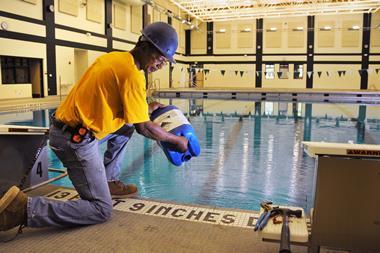Thousands of residents evacuated and kept indoors as as smoke and gas cloud persists for days
A BioLab manufacturing facility in Conyers, US, is continuing to release chlorine, chloramines and chlorine compounds in an incident that originated from a small rooftop fire in the early morning of 29 September. The fire activated a sprinkler system and doused water-reactive trichloroisocyanuric acid (TCCA) inside the building. This initiated a chemical decomposition reaction that released chlorine gas into the atmosphere.

The facility has had several similar incidents in the past, prompting serious concern from local authorities, as well as several new class action lawsuits against Biolab and affiliates. State lawmakers and local activists are now calling for the permanent shutdown of the BioLab plant.
No injuries were reported from the incident, but the huge plumes of smoke it created forced approximately 17,000 residents to be evacuated, nearly 90,000 people to shelter in place, and several major road closures. Days later, residents were still being urged to remain indoors at night as the cloud drifts through the area.
Georgia Institute of Technology’s Sally Ng, the leader of a new effort to characterise aerosol chemical composition and physical properties across the US in real time called the Atmospheric Science and Chemistry Measurement Network (Ascent), confirms to Chemistry World that the morning after the fire, the number of chlorine-containing particles detected in the air at Ascent’s Decatur, Georgia site, around 28km from the BioLab plant, had increased by about 1400 times. Bromine-containing particles in the air increases by about 170 times, she said.
Environmental, public health and emergency management officials in Georgia have joined the US Environmental Protection Agency (EPA) to continue monitoring air quality levels throughout the region. On 2 October, authorities reported that some chlorine measurements around the BioLab facility overnight continued to exceed federal action levels. They noted that progress was being made in neutralising the product, but said periodic increases in chlorine levels around the facility should be expected as that process continues.
Multiple previous incidents
The company manufactures pool and spa chemicals containing TCCA, which breaks down slowly to release disinfectant hypochlorous acid when dissolved in large bodies of water. But when the chemical encounters smaller amounts of water and does not dissolve, it can undergo chemical decomposition, generating significant heat and large volumes of chlorine gas.
The US Chemical Safety and Hazard Investigation Board (CSB) has sent a team to BioLab to investigate the incident. CSB chair Steve Owens noted that the CSB has previously investigated two Biolab plants – this one in Conyers, and another in Westlake, Louisiana. In September 2020, the agency investigated a chemical reaction and decomposition at the Conyers facility which exposed Biolab personnel and nine firefighters to hazardous chemicals, including chlorine. Four days later, a second decomposition involving TCCA occurred at the facility, also with no reported injuries.
The CSB investigated a separate, similar chemical release and fire at BioLab’s Westlake plant in August 2020. After the buildings were damaged by a hurricane, rainwater came into contact with TCCA stored inside, initiating decomposition and chlorine release.
In April 2023, the CSB issued a final investigation report addressing the previous incidents at the Biolab facilities in Conyers and Westlake, and it urged US federal regulators to consider stricter oversight of hazards associated with reactive chemicals.
Gap in regulations
The CSB report highlights that, despite its hazard potential, TCCA is neither regulated under the US Occupational Safety and Health Administration (OSHA) nor the EPA’s Risk Management Program rule that aims to improve chemical accident prevention. It also concluded that OSHA and the EPA did not adequately consider reactive chemical hazards in their rules, and, as a result, many reactive chemicals like TCCA are not covered by these regulations.
Chemical safety and security specialist Patrick Coyle says that, in general, companies rely on waterproof storage containers to prevent this type of incident. He suggests it’s possible that debris from the initial roof fire compromised storage containers and allowed water into contact with the TCCA. ‘The actual evolution will, hopefully, be determined by a detailed Chemical Safety Board investigation,’ he adds.
He also suspects that sprinkler-based fire suppression systems are relatively common, even in facilities that house water-reactive materials. ‘A deluge system, with extremely high-flow water, not sprinklers, would probably be a better option,’ he observes. ‘But those are much more expensive and the water runoff problems would be exacerbated.’
He suggests that the incident could affect supplies of pool treatment chemicals for the next year or two. ‘This industry does not start quickly,’ he observes.

















No comments yet